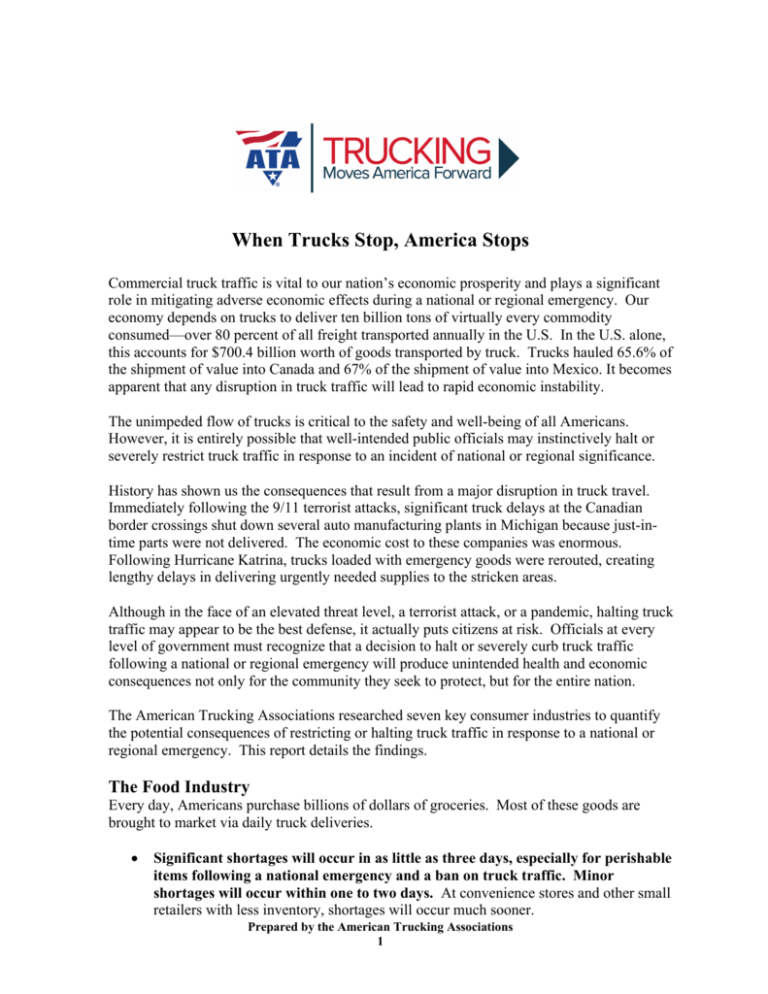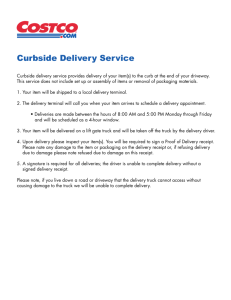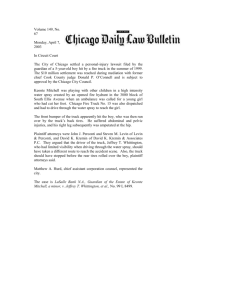When Trucks Stop, America Stops - American Trucking Associations
advertisement

When Trucks Stop, America Stops Commercial truck traffic is vital to our nation’s economic prosperity and plays a significant role in mitigating adverse economic effects during a national or regional emergency. Our economy depends on trucks to deliver ten billion tons of virtually every commodity consumed—over 80 percent of all freight transported annually in the U.S. In the U.S. alone, this accounts for $700.4 billion worth of goods transported by truck. Trucks hauled 65.6% of the shipment of value into Canada and 67% of the shipment of value into Mexico. It becomes apparent that any disruption in truck traffic will lead to rapid economic instability. The unimpeded flow of trucks is critical to the safety and well-being of all Americans. However, it is entirely possible that well-intended public officials may instinctively halt or severely restrict truck traffic in response to an incident of national or regional significance. History has shown us the consequences that result from a major disruption in truck travel. Immediately following the 9/11 terrorist attacks, significant truck delays at the Canadian border crossings shut down several auto manufacturing plants in Michigan because just-intime parts were not delivered. The economic cost to these companies was enormous. Following Hurricane Katrina, trucks loaded with emergency goods were rerouted, creating lengthy delays in delivering urgently needed supplies to the stricken areas. Although in the face of an elevated threat level, a terrorist attack, or a pandemic, halting truck traffic may appear to be the best defense, it actually puts citizens at risk. Officials at every level of government must recognize that a decision to halt or severely curb truck traffic following a national or regional emergency will produce unintended health and economic consequences not only for the community they seek to protect, but for the entire nation. The American Trucking Associations researched seven key consumer industries to quantify the potential consequences of restricting or halting truck traffic in response to a national or regional emergency. This report details the findings. The Food Industry Every day, Americans purchase billions of dollars of groceries. Most of these goods are brought to market via daily truck deliveries. • Significant shortages will occur in as little as three days, especially for perishable items following a national emergency and a ban on truck traffic. Minor shortages will occur within one to two days. At convenience stores and other small retailers with less inventory, shortages will occur much sooner. Prepared by the American Trucking Associations 1 • Consumer fear and panic will exacerbate shortages. The forecast of a winter storm quickly exhausts basic commodities at grocery stores and supermarkets. It takes retailers up to three days to recover from these runs on supplies. News of a truck stoppage—whether on the local level, state or regional level, or nationwide— will spur hoarding and drastic increases in consumer purchases of essential goods. Shortages will materialize quickly and could lead to civil unrest. • Supplies of clean drinking water will run dry in two to four weeks. According to the American Water Works Association, Americans drink more than one billion glasses of tap water per day. For safety and security reasons, most water supply plants maintain a larger inventory of supplies than the typical business. However, the amount of chemical storage varies significantly and is site specific. According to the Chlorine Institute, most water treatment facilities receive chlorine in cylinders (150 pounds and one ton cylinders) that are delivered by motor carriers. On average, trucks deliver purification chemicals to water supply plants every seven to 14 days. Without these chemicals, water cannot be purified and made safe for drinking. Without truck deliveries of purification chemicals, water supply plants will run out of drinkable water in 14 to 28 days. Once the water supply is drained, water will be deemed safe for drinking only when boiled. Lack of clean drinking water will lead to increased gastrointestinal and other illnesses, further taxing an already weakened healthcare system. Healthcare Both healthcare providers and consumers rely on regular delivery of medications and healthcare supplies to hospitals, pharmacies, nursing homes and other healthcare facilities. Trucks deliver nearly all of these supplies. Al Cook, former president of the Materials Management Association and current member of the Medical Materials Coordinating Group, which is advising the U.S. Department of Health and Human Resources on emergency preparedness, describes over-the-road commercial transportation as “life and death to being able to care for sick people.” • Without truck transportation, patient care within the truck stoppage zone will be immediately jeopardized. According to Cook, many hospitals have moved to a justin-time inventory system. In fact, some work from a low-unit-of-measure system. This means that essential basic supplies, such as syringes and catheters, are not ordered until the supplies are depleted. These systems depend on trucks to deliver needed supplies within hours of order placement. Internal redistribution of supplies in hospitals could forestall a crisis for a short time; however, in a matter of hours, hospitals would be unable to supply critical patient care. • If an incident of national significance produces mass injuries, truck transportation is the key to delivering urgently needed medical supplies necessary to save lives. According to Cook, there are not enough medical supplies in any local area to support a large scale medical emergency. The Medical Materials Coordinating Group has worked with U.S. Health and Human Services to develop contingency plans that will coordinate national redistribution of essential medical supplies during a national emergency. Prepared by the American Trucking Associations 2 These contingency plans ensure that affected areas receive adequate medical supplies to support the crisis while also maintaining adequate supplies for the basic medical needs of the larger community. Cook states that the medical redistribution program relies on trucks as the primary mode of transport to carry out the expedient redistribution of supplies, and ties the success of the program to the ability of trucks to access medical facilities and warehouses during an emergency situation. • Hospitals and nursing homes will exhaust food supplies in as little as 24 hours. Hospitals and nursing homes receive daily truck deliveries of food for patients. The International Food Distributors Association notes that because these facilities lack significant warehousing capabilities, a truck stoppage will result in food shortages within 24 to 48 hours, particularly among perishable items. • Pharmacy stocks of prescription drugs will be depleted quickly. Although pharmacies typically carry several weeks inventory of many drugs, seasonal pharmaceuticals, such as antibiotics and flu-shots during winter months, have faster turnover rates. According to the National Association of Chain Drug Stores, most of the nation’s 55,000 drug stores receive daily merchandise deliveries by truck. • Hospitals and other diagnostic and treatment facilities will exhaust supplies of radiopharmaceuticals and oxygen. Radiopharmaceutical supplies for cancer treatment and diagnostic services, which have an effective life of only a few hours, will become unusable. Hospital size and storage capacity determine the amount of oxygen a facility can maintain; however, in general, hospitals will exhaust oxygen supplies within seven to ten days. Transportation The impact of a truck stoppage would not be limited to highway transportation but would affect all modes of transportation. Trucks are the fundamental unit within the transportation sector. Trucks transport just about all cargo to and from air and rail terminals and maritime ports. Trucks also deliver fuel to the majority of rail yards. The Air Transport Association estimates that trucks account for approximately 80 percent of the fuel deliveries to the nation’s airports. Truck transport is the mechanism for fuel delivery to service stations and truck stops. • Service station fuel supplies will start to run out in just one to two days. According to the Service Station Dealers of America, the nation’s busiest fuel stations sell between 200,000 and 300,000 gallons per month. These stations require multiple deliveries every day to meet this demand. An average service station requires a delivery every 2.4 days. Based on these statistics, the busiest service stations could run out of fuel within hours of a truck stoppage, with the remaining stations following within one to two days. Researchers predict that automobile travel will cease within one week if fuel deliveries are halted. Air, rail and maritime transportation will be disrupted. Airlines and air cargo operations will be grounded due to the lack of supplies for operations. Railroads will cease all truck trailer-on-flat-car or piggy-back and container operations. Rail freight Prepared by the American Trucking Associations 3 will pile up at rail terminals since intermodal trucks provide the first and last mile in intermodal moves. Smaller railroads (Classes 2 and 3) will stop operation due to lack of truck-supplied fuel and will create significant congestion on feeder lines to the large (Class 1) railroads. If the truck stoppage occurred in a coastal region, inbound and outbound container ships, which rely on intermodal truck transportation, will sit idle at the maritime ports. • A fuel shortage will create secondary effects. Without access to automobile travel, people will be unable to get to work causing labor shortages and increased economic damage. Without cars, many people cannot access grocery stores, banks, doctors, and other daily needs. Public bus systems will cease to operate as well, preventing many disabled and elderly people from accessing these necessities. Without fuel, police, fire, rescue and other public service vehicles will be paralyzed, further jeopardizing public safety. U.S. Mail and other package delivery operations will cease. Within two days, garbage will start to pile up in urban and suburban areas due to a lack of regular pick ups, creating a health hazard. Waste Removal The Environmental Protection Agency estimates that Americans generate more than 236 million tons of municipal or household waste annually. This does not take into account manufacturing, medical, or other types of commercial waste. • Within days of a truck stoppage, Americans will be literally buried in garbage with serious health and environmental consequences. Further, without fuel deliveries, many waste processing facilities will be unable to operate equipment such as backhoes and incinerators. • Uncollected and deteriorating waste products create rich breeding grounds for microorganisms, insects, and other vermin. Hazardous materials and medical waste will introduce toxins as well as infectious diseases into living environments. Urban areas will, of course, be significantly impacted within just a couple of days. But rural and agricultural areas as well as food processing plants will be impacted as well. Without waste removal and treatment, food wastes, such as slaughtered animal byproducts and overripe fruits and vegetables will create extremely toxic conditions. • Beyond the health risks, a lack of waste removal creates pollution hazards. Biological pathogens, hazardous chemicals and even radioactive materials will be released into the soil, water, and atmosphere. And, the sheer volume of uncollected waste could block water run off and drainage leading to pooling and flooding. The Retail Sector A disruption of truck deliveries to retail outlets will have serious effects on both consumers and retailers. • Replenishment of goods will be disrupted. Many of the nation’s leading retailers rely on just-in-time delivery to keep inventory levels as low as possible. Similar to Prepared by the American Trucking Associations 4 the low-unit-of-measure hospital inventory system, these stores rely on frequent deliveries to replenish basic goods. Often, delivery of a shipment is not triggered until the current inventory is nearly depleted. Without truck deliveries, retailers will be unable to restock goods, including consumer basics such as bottled water, canned goods, and paper products. • Consumer behavior during emergencies triples the rate of inventory turn-over. Since many large retail outlets typically keep inventories as lean as possible, problems often arise quickly during truck transportation slowdowns that occur from crises such as hurricanes. In a hurricane situation, supplies that would normally last a few days, such as water, powdered milk, and canned meat, typically disappear within one day. Given these inventory rates, this means that perishable goods could be depleted in a matter of days and non-perishables in just a few days. Runs on food and non-food staples during hurricanes, and even before big winter storms, provide a good example of how fast some retail inventories can be depleted during panic buying. The same quick depletion of inventories could occur if trucks stopped making deliveries for any reason. Manufacturing In recent years, manufacturers in the United States have shifted increasingly to just-in-time manufacturing. Aimed at improving efficiency, just-in-time manufacturing reduces the need for extensive warehousing of manufacturing components because parts and components are delivered to the production line just hours before assembly. As a result, manufacturers are extremely sensitive to disruptions in the supply chain. • Just-in-time manufacturers will shut down assembly lines within hours. Major American manufacturers, ranging from computer manufacturers such as Dell and Compaq to major automakers such as GM and Ford, rely on just-in-time manufacturing. Without truck deliveries, component shortages and manufacturing delays will develop within hours. If assembly lines are forced to shut down, manufacturers will incur significant disruption costs and thousands of employees will be put out of work. Just-in-time manufacturers also rely on trucks to transport goods to the market within hours of assembly. A truck stoppage will cripple deliveries to retailers. Banking & Finance Even with today’s high-tech electronic exchange of currency and information, trucks play a critical role in transporting hard copies of financial documents and currency. Disruption of truck deliveries to banks and ATMs will paralyze the banking industry, affecting both consumers and businesses. The bottom-line: cash is still heavily used as legal tender. • ATM and branch bank cash resources will be exhausted quicky. In today’s fastpaced, high-technology economy, consumers access cash 24/7 from over 370,000 ATMs nationwide. JP Morgan Chase, the nation’s second largest consumer bank, replenishes its 6,600 ATMs via armored truck delivery every two to three days. Prepared by the American Trucking Associations 5 Given the increase in ATM activity that occurs before and after any type of crisis, ATMs would run out of cash much sooner. • Small and medium-size businesses will lose access to cash. Banks provide daily cash and coin deliveries to thousands of small and medium-size businesses via armored trucks. According to JP Morgan Chase, without these daily deliveries and collections, the ability of businesses to carry out normal commercial transactions will be disrupted and eventually cease. • Regular bank functions will cease. Bank branches transfer paper documents for every transaction, via daily truck service, to a central location for processing. Unable to conduct transactions at a central location, banks will be unable to process deposits, checks, and other standard bank transactions, bringing the American banking system to a halt. Other Effects In addition to the effects on the key industries outlined in this paper, a ripple effect could significantly disrupt a variety of services and activities beyond the affected area, extending into communities nationwide. For example, the Department of Defense (DoD) supply chain includes 1,100 shipping points inside the United States, connects to airports and seaports, and is the supply lifeline to warfighters deployed globally. Nearly all DoD freight involves truck movement and all trucks with DoD freight are subject to orders by local law enforcement. Stopping trucks with DoD freight would ultimately cripple the Department of Defense in ways no adversary has been able to achieve. A truck stoppage in the Great Lakes region will close down auto manufacturing, steel mills, and other major industries, not only putting thousands of workers out of work, but also disrupting the flow of automobiles and steel products to the rest of the nation. A stoppage at harvest time in or around any of the nation’s agricultural regions will cut off the transport of fresh foods, such as fruits, vegetables, and grains. Not only would Americans be deprived of fresh foods, the economic impact to the farming industry would be devastating. Consider a truck stoppage in the states around Washington, D.C. The federal government will be slowed down within a week and could grind to a halt within two or three weeks. Moreover, a truck stoppage in a major metropolitan area will result in rapid depletion of food, bottled water, and critical medical supplies, potentially leading to civil unrest as citizens compete for basic necessities. Conclusion As demonstrated by the analysis of just a few key industries, restricting or shutting down all truck operations in response to a natural disaster, elevated threat level, terrorist attack, or pandemic will have a swift and devastating impact on the food, healthcare, transportation, waste removal, retail, manufacturing, and financial sectors. Members of the trucking industry must educate government officials at the local, state, and federal levels about the dire consequences of a truck stoppage. At first glance, halting all Prepared by the American Trucking Associations 6 truck travel appears to be a powerful tool to neutralize a terrorist threat or protect citizens from a pandemic. However, this is a solution that could be worse than the problem. Instead, we must urge governments at all levels to develop contingency and action plans that use sophisticated techniques to isolate and respond to a threat. Working together, ATA believes that a solution can be found that avoids the ruinous effects that will be brought about by a freeze on truck travel. Prepared by the American Trucking Associations 7 Case Study: The Effect of Border Delays on Auto Manufacturers Following September 11th The auto industry is one of the manufacturing industries that has extensively integrated just-in-time inventory techniques. According to Supply Chain Management Review, the auto industry has saved $1 billion over the past decade through just-in-time techniques. Every day, auto manufacturing plants located along the Canadian border in Michigan receive numerous truck deliveries from auto parts plants in Canada. These parts will be assembled into autos and shipped within hours of delivery. While the just-in-time manufacturing process is efficient, the experience of auto manufacturers during the days following September 11th showed the sensitivity of assembly lines to disruptions in the components and parts supply chain. Immediately following September 11th, stringent security measures (and some closings) at border crossings created delays ranging from 12 to 36 hours at certain checkpoints, including the crossing between Detroit, Michigan, and Windsor, Ontario. Approximately 7,400 trucks carrying commerce worth half-a-billion dollars flows across this checkpoint every day. The border crossing delays caused shutdowns in operations at assembly plants operated by Ford, General Motors, DaimlerChrysler AG, Toyota Motor Sales, and American Honda Motor Company. Mark Nantais, head of the Canadian Vehicle Manufacturer’s Association, estimates that these shutdowns cost auto manufacturers $1.5 million per hour. In the first week following September 11th, Ford’s production fell by 16,000 vehicles due to component shortages and GM’s production fell by 10,000 vehicles. In the following months, according to a study by the Center for Automotive Research in Ann Arbor, Michigan, continued delays slowed manufacturing speed, causing losses of approximately $60,000 per hour for assembly plants. Despite the disruptions caused by the border crossing delays, the just-in-time method is so important to corporate competitiveness that the model remains in place today. As a result, manufacturers continue to be sensitive to supply disruptions. A disruption as large and significant as a truck stoppage—whether local, regional or nationwide—will have a similar impact on auto and numerous manufacturing industries, with enormous costs stemming from reduced sales, lost production, and lost employment. Prepared by the American Trucking Associations 8 When Trucks Stop, America Stops A Timeline Showing the Deterioration of Major Industries Following a Truck Stoppage The first 24 hours • • • • • Within one day • • • Within two to three days • • • • • • Within a week • Delivery of medical supplies to the affected area will cease. Hospitals will run out of basic supplies such as syringes and catheters within hours. Radiopharmaceuticals will deteriorate and become unusable. Service stations will begin to run out of fuel. Manufacturers using just-in-time manufacturing will develop component shortages. U.S. mail and other package delivery will cease. Food shortages will begin to develop. Automobile fuel availability and delivery will dwindle, leading to skyrocketing prices and long lines at the gas pumps. Without manufacturing components and trucks for product delivery, assembly lines will shut down, putting thousands out of work. Food shortages will escalate, especially in the face of hoarding and consumer panic. Supplies of essentials—such as bottled water, powdered milk, and canned meat—at major retailers will disappear. ATMs will run out of cash and banks will be unable to process transactions. Service stations will completely run out of fuel for autos and trucks. Garbage will start piling up in urban and suburban areas. Container ships will sit idle in ports and rail transport will be disrupted, eventually coming to a standstill. • Automobile travel will cease due to the lack of fuel. Without autos and busses, many people will not be able to get to work, shop for groceries, or access medical care. Hospitals will begin to exhaust oxygen supplies. Within two weeks • The nation’s clean water supply will begin to run dry. Within four weeks • The nation will exhaust its clean water supply and water will be safe for drinking only after boiling. As a result gastrointestinal illnesses will increase, further taxing an already weakened health care system. This timeline presents only the primary effects of a freeze on truck travel. Secondary effects must be considered as well, such as inability to maintain telecommunications service, reduced law enforcement, increased crime, increased illness and injury, higher death rates, and likely, civil unrest. 7 Prepared by the American Trucking Associations 9 2015






